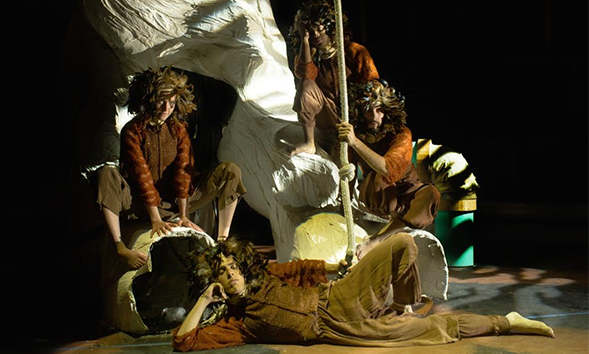Dressing the Jungle
SDSU's "Jungle Book" is brought to life with quirky and playful costume designs.

This semester, SDSU NewsCenter will focus on the arts with stories of the creative endeavors of our students, faculty, staff and alumni.
SDSU’s adaptation of the classic children’s tale by Rudyard Kipling, "Jungle Book," brings to life many animals of the jungle in unique and creative ways.
Jordyn Smiley, the costume designer of the production and a third year Masters of Fine Arts student majoring in theater design and technology with an emphasis in costume design, was given "Jungle Book" as her thesis show.
Smiley said she took the opportunity as a chance to let her imagination run wild, literally.
“I usually do very period-based shows where there is a definite historical reference that I am researching. This is all in your head; it’s whatever you want it to be, so there was a lot of creative freedom,” Smiley said.
Initial conversations about design angles began as early as August 2013. After several discussions with the set and lighting designers, Smiley selected her final fabrics in early January. From there, Smiley and the SDSU costume shop team began constructing the jungle animals she imagined.
Human versus animal
The idea behind the design was to avoid creating mascot-looking animals on stage. Smiley wanted the characteristics of the animals to be brought to life mostly by the actors’ performances.
“We rely a lot on the actors’ movements to portray the animals’ figures. The animalistic qualities come more from the textures and the silhouettes of the costumes as opposed to the actual pieces,” Smiley said.
Smiley worked to balance humanistic and animalistic qualities when designing for the production. It was important to her and Margret Larlham, the director of the show, to have a combination of both human and animal portrayals when telling the story.
Boy in the jungle
Mowgli, the main character, is the inspiration of the themes behind the costume designs. He is the boy from the human world that learns the ways of the wild when he finds himself in the jungle.
Smiley put heself in Mowgli's shoes when thinking about her approach to his costume. She decided that distressing and repurposing would be the main elements for Mowgli’s outfit.
“The idea is that later when we see Mowgli, its five years later and he’s been in the jungle. He wouldn’t have a needle and thread, so he has to use what’s around him,” Smiley said.
The older Mowgli uses his original shirt as a loin cloth and uses just the sole and laces of his original shoes. Those pieces in combination with earthy-toned materials he found during his adventures in the jungle encompass the older, more wild Mowgli.
“It brings him into the jungle world while still retaining some of the human elements of where he used to come from,” Smiley said.
Stage presence
There are many different sizes and shapes to the animals of the jungle and Smiley had the opportunity to creatively adapt these animals so they pop on stage.
A fun solution she came up with to give the actress playing Hathi, the elephant, some height, was to put her on stilits.
“It’s really playing with a lot of illusion. We ended up putting her on five gallon buckets as stilts. So not only does that raise her up so that she’s taller than all of the other animals, it forces her to walk with her feet very far apart and slowly. It really adds to the characteristic of the elephant when she’s on stage,” Smiley said.
Kaa, the snake, was made into a puppet for SDSU’s adaptation. The actress playing Kaa was kept in mind when Smiley was designing how the puppet would move and interact with the other characters in the show.
“The costume that the girl wears corresponds to the fabrics of the puppet itself, so she becomes one with the puppet, not just an actor holding a snake on stage,” Smiley said.
It was very important to Smiley that the snake be transparent so the audience could see the inner workings of the snake. Another fun element is Kaa’s LED-lit eyes that are bright enough to hypnotize the audience from the stage.
“It’s important to remember what it will look like on stage. It’s a good lesson to not be afraid of some things because while it may seem really bold or overwhelming, on stage it works quite nicely,” Smiley said.
See the show
The Jungle Book runs through May 4 at SDSU’s Don Powell Theater. Visit SDSU’s School of Theater, Television and Film website for times, more information and to purchase tickets.



